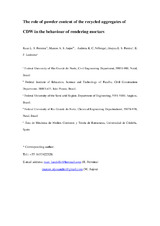Mostrar el registro sencillo del ítem
The role of powder content of the recycled aggregates of CDW in the behaviour of rendering mortars
| dc.contributor.author | Ferreira, Ruan L. S. | |
| dc.contributor.author | Anjos, Marcos A.S. | |
| dc.contributor.author | Nóbrega, Andreza K.C. | |
| dc.contributor.author | Pereira, Jéssyca E.S | |
| dc.contributor.author | Fernández Ledesma, Enrique | |
| dc.date.accessioned | 2024-02-07T11:52:28Z | |
| dc.date.available | 2024-02-07T11:52:28Z | |
| dc.date.issued | 2019 | |
| dc.identifier.issn | 0950-0618 | |
| dc.identifier.uri | http://hdl.handle.net/10396/27235 | |
| dc.description.abstract | In recent years, the number of studies on the incorporation of recycled aggregate (RA) into mortars has grown considerably. However, mixed recycled aggregate (MRA) is investigated on a much smaller scale due mainly to its high-water absorption capacity and higher powder content (<.150 mm). As a result, large volumes of this RA is stored in recycling plants, offering no alternatives that allow it to be used in construction, further aggravating the problems involved in the generation and destination of construction and demolition waste (CDW). This study evaluated the effects of this aggregate used with and without powder content on physical properties (fresh bulk density, incorporated air content, water retention, capillary absorption and porosity), mechanical properties (compressive strength, flexural strength, modulus of dynamic elasticity and adhesion to substrate) and the susceptibility of cracking of mortars. The natural aggregate (NA) was replaced by MRA at 25%, 50%, 75% and 100%. The mortars were mixed using a 1:1:6 volume ratio (cement: lime hydrated: aggregate). The results showed that the physical-mechanical behaviour of the mortars improved, as the content of MRA with higher powder content increased. On the other hand, higher percentages of NA replaced by MRA contributed to the excessive emergence of micro-cracks in the renderings. Finally, we have verified that the use of MRA of CDW for the production of rendering mortar is feasible, especially when there are aggregates with adequate granulometric composition and, preferably, free of powder. | es_ES |
| dc.format.mimetype | application/pdf | es_ES |
| dc.language.iso | eng | es_ES |
| dc.publisher | Elsevier | es_ES |
| dc.rights | https://creativecommons.org/licenses/by-nc-nd/4.0/ | es_ES |
| dc.source | Ferreira, R. L., Anjos, M. A., Nóbrega, A. K., Pereira, J. E., & Ledesma, E. F. (2019). The role of powder content of the recycled aggregates of CDW in the behaviour of rendering mortars. Construction and building materials, 208, 601-612. https://doi.org/10.1016/j.conbuildmat.2019.03.058 | es_ES |
| dc.subject | Construction and demolition waste | es_ES |
| dc.subject | Mixed recycled aggregate | es_ES |
| dc.subject | Mortar | es_ES |
| dc.subject | Filler effect | es_ES |
| dc.title | The role of powder content of the recycled aggregates of CDW in the behaviour of rendering mortars | es_ES |
| dc.type | info:eu-repo/semantics/article | es_ES |
| dc.relation.publisherversion | https://doi.org/10.1016/j.conbuildmat.2019.03.058 | es_ES |
| dc.rights.accessRights | info:eu-repo/semantics/openAccess | es_ES |

